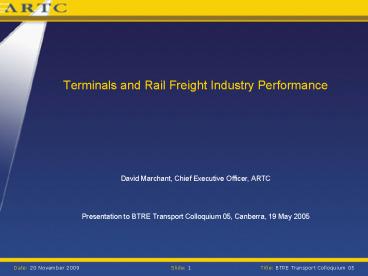Terminals and Rail Freight Industry Performance PowerPoint PPT Presentation
1 / 14
Title: Terminals and Rail Freight Industry Performance
1
- Terminals and Rail Freight Industry Performance
- David Marchant, Chief Executive Officer, ARTC
- Presentation to BTRE Transport Colloquium 05,
Canberra, 19 May 2005
2
Key areas to be covered
- Rail Freight Performance on the East West Rail
Network - Key impediments to increasing north south
interstate rail freight transport - Investment in the north-south interstate rail
network - Intermodal terminals and competition
- What are the options?
3
Performance on the East-West Rail Network.
- STRONG GROWTH IN INTERMODAL VOLUMES CONTINUES..
- Volume over the last 12 months has been nearly
15 higher than the previous 12 months.
4
Performance on the East-West Rail Network.
- Rail efficiency has improved ...
- and
- access costs have fallen
5
Rail market share of interstate intermodal
markets.
- Significant differences in markets and
competitiveness between corridors
6
Performance on the East-West Rail Network.
- It has been reported that rail reliability levels
have deteriorated on east-west corridors over the
last 2 years - This has been reflected in
- rail reliability measures on
- the ARTC network.
- On time exit from the
- network generally tracks
- on time entry to the
- network.
- In many cases, trains enter the network late from
terminals due to congestion in the terminal
arising from the rapid growth of container
volumes that have been experienced over the last
few years. Terminal capacity has become
constrained. Key east-west intermodal terminals
are in Melbourne and Sydney. Access to the
intermodal terminal in Melbourne is also
congested.
7
Key impediments to increasing north south
interstate rail freight transport
- Infrastructure performance capacity
- Above rail capacity
- Terminal availability capacity in Sydney
Brisbane - Regulation network access, safety, operating
practises - Ability to integrate into wider logistics
networks - Flexibility
- Information flow
- Efficiency at interfaces (terminals, ports)
- Infrastructure pricing
8
Investment in the north-south interstate rail
network
- GETTING THE INVESTMENT RIGHT
- Around 1.7bn over the next 5 years
- ARTCs Initial Investment Program in NSW/Victoria
around 700m - predicated on the National Audit Objectives, and
marketplace expectations for transit time, axle
load, service reliability, etc. - 450m Australian Government grant ARTC proposes
to invest in the important Sydney Brisbane
corridor - 550m AusLink commitment improve rail market
share and urban efficiency - A further 145m to improve the Hunter Valley coal
chain capacity.
9
Investment in the north-south interstate rail
network.
- PROPOSED PROJECTS OUTCOMES
10
Investment in the north-south interstate rail
network.
- GROWTH PROJECTIONS - GTK
11
Investment in the north-south interstate rail
network.
- IMPACT OF NORTH-SOUTH GROWTH ON EAST COAST CITIES
INTERMODAL TERMINALS - 10 Year Terminal Throughput Growth
- Achievement of north-south interstate growth
projections resulting modal shift and underlying
transport growth will more than double throughput
of intermodal terminals in Melbourne, Sydney and
Brisbane - Includes in/out movements only (not through
movements) - Excludes impact of further east-west growth
(around 4pa) - Excludes regional movements (eg northern
Queensland, NSW/Victoria country) - Excludes ancilliary movements
- Port-generated traffic in metropolitan areas
places another strain on intermodal terminal
capacity. - Existing terminal capacity appears to be
affecting rail freight performance at existing
volume levels. - Without investment in existing and new intermodal
facilities in all of these locations, volume
growth projections will not be achieved.
12
Investment in the north-south interstate rail
network.
- IMPACT OF NORTH-SOUTH GROWTH ON EAST COAST CITIES
INTERMODAL TERMINALS - Intermodal Terminal Development Considerations
Constraints - Planning responsibility
- Location (Near major highways/rail connections,
proximity to existing industry) - Land (flat/space, buffering from conflicting land
usage) - Ability of surrounding road network to handle
heavier usage - Terminal-port connections (rail/road) most
governments have targeted rail market share of
30-40. - Cost (land/infrastructure) funding
- Management (Multi-user/dedicated user)
13
Intermodal Terminals and Competition.
- Key elements necessary to compete in the rail
transport market - Access to available network capacity at the right
time and at reasonable terms conditions - Access to Terminal space
- Locomotives
- Rolling Stock
- Critical mass (high fixed cost industry)
- Access to key intermodal terminals is a primary
pre-requisite to being able to enter and compete
in the rail market - Terminal space is a scarce resource in Melbourne,
Sydney and Brisbane, and duplication is
prohibitive. - Most intermodal facilities are not subject to
access regulation. - Terminal operators tend to be subsidiaries of
large vertically integrated service providers
with interests competing against other providers
and new entrants for timely access to terminals. - Intermodal terminals become a key strategic asset
for owners that can be used to constrain
competition in the intermodal rail transport
industry.
14
What are the options?
- Hubbing
- Inland or outer metropolitan intermodal terminals
- Shunting to/from main intermodal terminal or port
- Opportunity for rail
- Environmental/congestion benefits
- ARTC is working with the industry and relevant
agencies to explore options for greenfields
terminal development in Sydney and Brisbane - Ultimately market forces will dictate where
terminals will exist and how they will be
integrated with wider logistics networks. - ARTC is a track owner. Why is it interested in
terminals? - To protect its investment in the north-south rail
network. - ARTC needs strong intermodal growth and healthy
competition in rail transport. - Terminal capacity is fundamental to achieving
these objectives.

